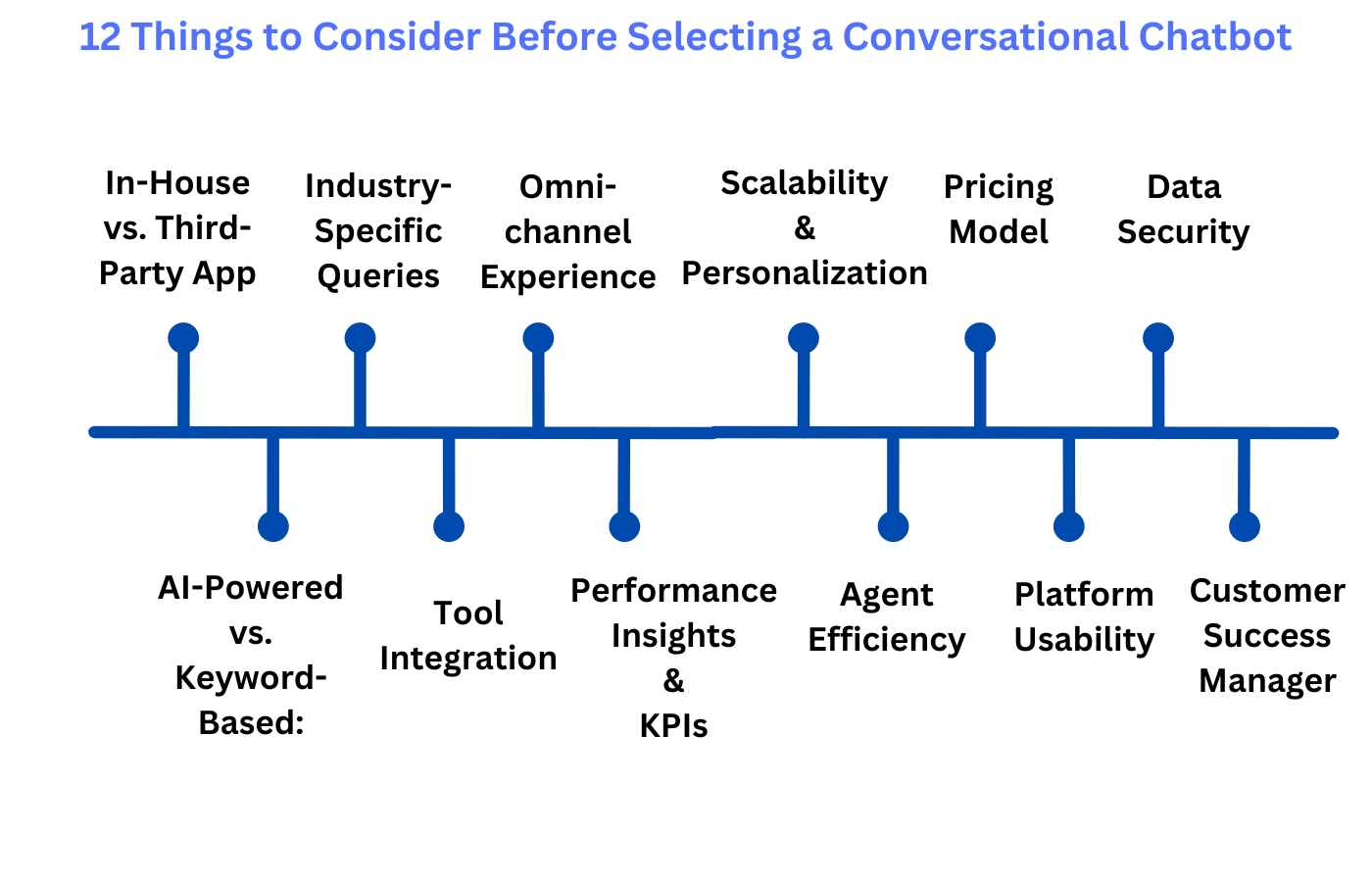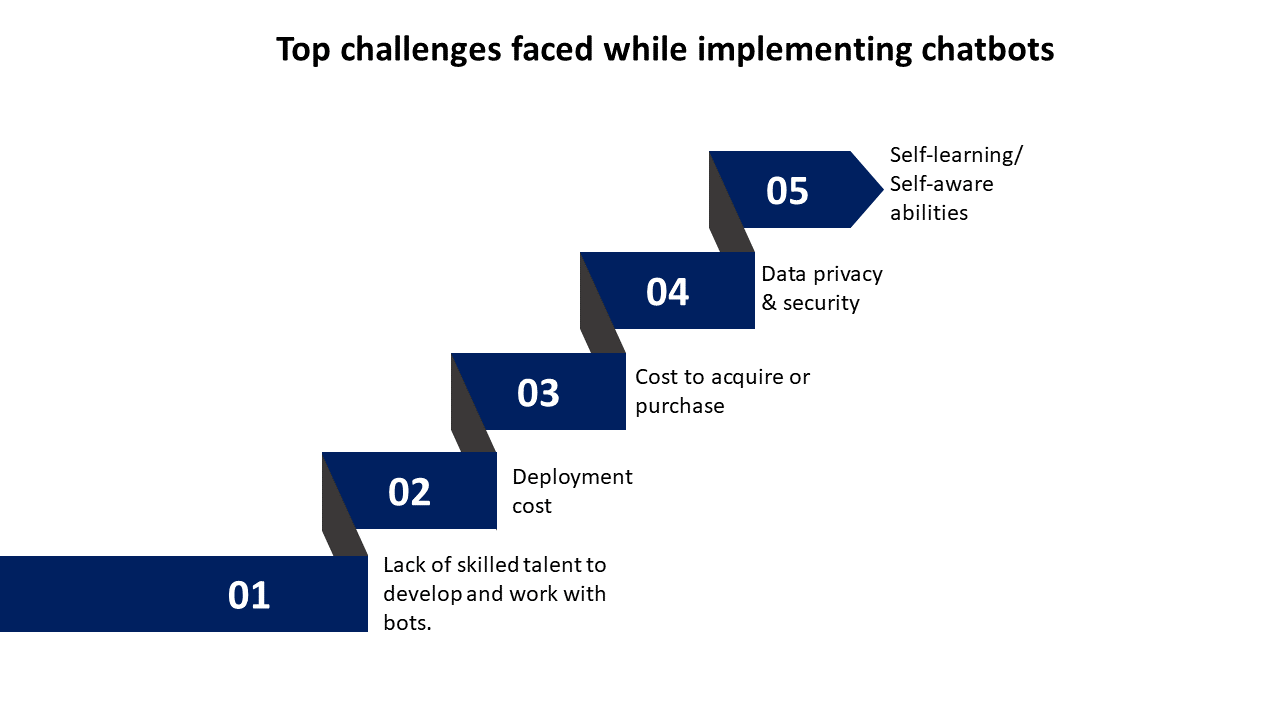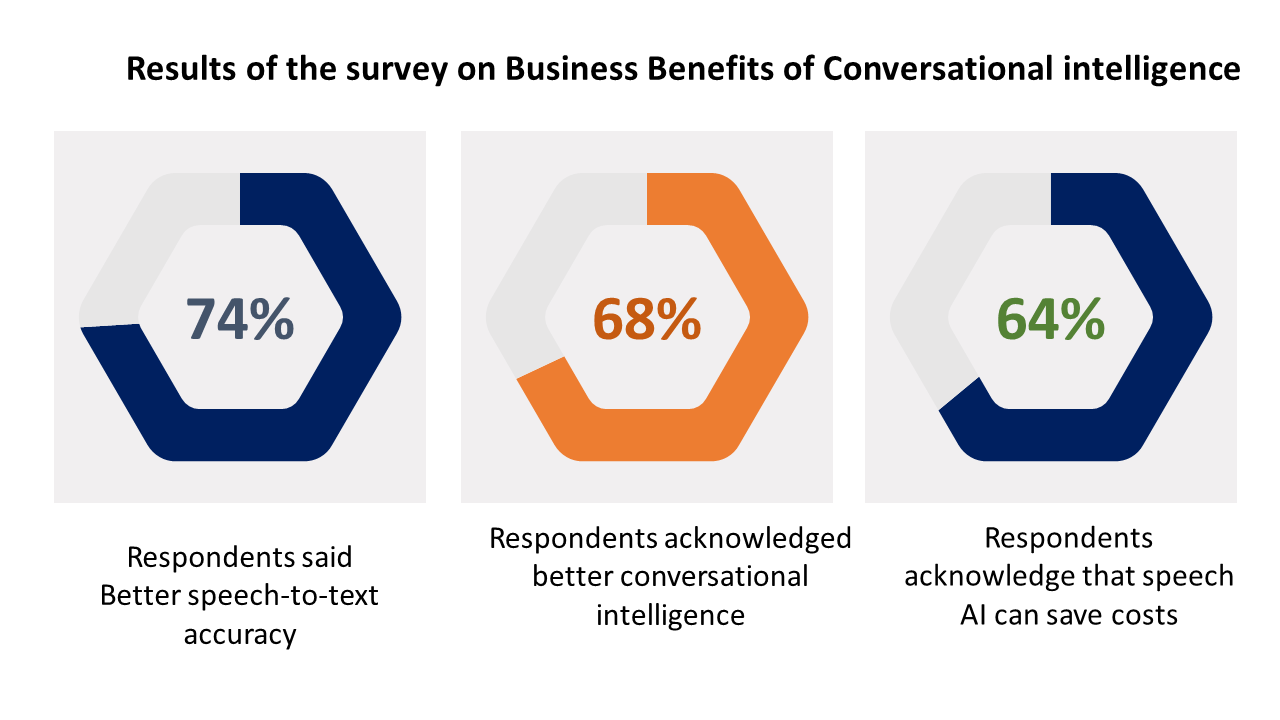Table of Contents
Conversational AI is becoming more and more integrated into our daily lives, whether it is through voice-activated assistants in our homes and smartphones or text-based chatbots on websites. The global conversational AI market was valued at USD 4.2 billion in 2019 and is expected to reach USD 32.62 billion by 2030, reflecting a significant growth trajectory. These cutting-edge AI systems are removing the barriers that separate authentic human connection from computer interfaces by imitating human speech patterns. They provide scalable, smooth, and customized user experiences.
Choosing the appropriate solution that yields business benefits is crucial when it comes to conversational AI. Although each platform will need to be tailored, the most important thing will be to make sure it can readily grow and handle large volumes of conversations.
Given how quickly new technologies are emerging, businesses need systems that can adapt to these changes and remain dependable. This post will explain conversational AI and show you how to select the best conversational AI platform for your needs.
What is a Conversational AI platform?
Technologies that help users to talk to them, for example, chatbots or virtual agents, these technologies are referred to as conversational artificial intelligence services. To mimic human interactions, they make use of massive amounts of data, machine learning, and natural language processing. They can recognize speech and text inputs and translate their contents between different languages.
Natural language processing solutions, or NLP, are combined with machine learning technology to create conversational AI. The AI algorithms are continuously improved by these NLP processes flowing into a continuous feedback loop with machine learning processes.
Components of conversational AI
The fundamental elements of conversational AI enable it to comprehend, process, and respond naturally.
Machine Learning
A branch of artificial intelligence service called machine learning technology is composed of a collection of features, algorithms, and data sets that get better over time. The AI platform computer learns to identify patterns in the increasing amount of data and applies that learning to forecast outcomes.
Natural Language Processing
The current approach to language analysis using machine learning in conversational AI is natural language processing. Before machine learning, linguistics, computational linguistics, and statistical natural language processing were the stages in the development of language processing techniques. Deep learning is expected to further enhance conversational AI’s natural language processing powers in the future.
Four steps make up natural language processing (NLP):
- input generation,
- input analysis,
- output production, and
- reinforcement learning.
Unstructured data is converted into a machine-readable format, which is processed to produce the right answer. As ML learns over time, the response quality is improved by the underlying algorithms.
Make a Difference in Your Business With Conversational AI and Automation
Capabilities of a Conversational AI Platform: Top Features and Benefits
In the last few years, artificial intelligence has evolved greatly, becoming more commonplace than just a futuristic possibility. These days, many businesses are utilizing certain AI technologies, while others are just testing them out. Text recognition, sentiment analysis, computer voice, intelligent automation, computer vision, machine learning, and many more services that improve human lives are all included in artificial intelligence (AI). As it is difficult to evaluate AI products side by side, selecting AI apps and software is far more difficult than purchasing other business software. A few pointers on selecting the best artificial intelligence software for your business are provided below:
Cost Efficient
Staffing a customer support department can be costly, particularly if you wish to answer questions outside typical office hours. In particular, for small and medium-sized organizations, conversational interfaces for customer service can reduce operating expenses associated with payroll and personnel development. Virtual assistants and chatbot development are always available to potential customers, responding instantaneously. 30% of conversations in live chat can be handled by chatbots. Inquiries from clients and 80% of regular duties can also be handled effectively by them.
Responses to prospective clients that are inconsistent might also come from human conversations. Businesses can develop conversational AI to handle a variety of use cases, assuring comprehensiveness and consistency, as the majority of support interactions include information-seeking and repetition. This maintains consistency in the client experience and frees up important human resources for more complicated inquiries.
Enhanced revenue and customer engagement
Due to customers’ increasing integration of mobile devices into their daily lives, firms must be ready to give their end users access to real-time information. Customers may interact with brands faster and more frequently thanks to conversational AI solutions, which are easier to reach than human workforces. Digital assistants with quick response times are favored by 69% of users. 59% of respondents want a chatbot response in under five seconds. Customers can avoid lengthy wait periods at call centers thanks to this instant assistance, which enhances their overall experience. Businesses will notice a rise in client loyalty and referral income as a result of higher customer satisfaction levels.
Businesses can cross-sell clients on things they may not have first considered by using chatbots that can make suggestions to end users based on personalization elements found in conversational AI.
Scalability
Because it is faster and less expensive to deploy infrastructure to support conversational AI than it is to hire and onboard new personnel, conversational AI is also incredibly scalable. This is particularly useful when items enter new markets or when demand spikes occur unexpectedly and temporarily, such as during the holidays.

Top Conversational AI Platforms businesses Use
Modern contact centers are rapidly incorporating conversational AI and chatbot technology into their operations. These technologies have the unique ability to mimic human communication through natural language processing and understanding. Ultimately, this has the potential to revolutionize your company’s self-service approach.
Additionally, a lot of conversational AI services can boost and enhance agent efficiency and open doors to valuable consumer data insights. Experts estimate that the conversational AI and chatbot market will reach a staggering $29.8 billion in value by 2028. Large language models and generative AI are two examples of innovative technologies that have made today’s vendor tools more sophisticated and potent than before.
To provide you with this list of the top suppliers in the market, we’ve looked at some of the greatest conversational AI platforms available right now.
Google DialogFlow
Source: Google Cloud
Google Dialogflow is a product of the tech powerhouse Google. It ranks high among the top Conversational AI Platforms today. This tool signifies Google’s effort to make tech easy, personal, and friendly for all. With Dialogflow, businesses can create tools like chatbots or voice systems. These make talking to businesses so easy.
Why is Dialogflow special? Let’s touch on a few key points:
- Built-in Natural Language Processing (NLP): Dialogflow has built-in NLP. This lets it get what users write or speak, looking deeper than just words. It tries to understand what the user means. Also, this kind of understanding lets it talk more like a human. Hence, this makes users happy.
- Cross-Platform Integration: Another big win for Dialogflow is how it fits everywhere. Be it a website, a phone app, or even conversational apps like Facebook Messenger or Slack, Dialogflow works with all. Also, this means businesses are always there for users, regardless of where they chat.
- Customizable Workflows: Every company is different. So, Dialogflow lets businesses change things as they want. This way, they don’t have to stick to a standard setup.
How Businesses Can Benefit from It?
Dialogflow is more than ordinary conversational AI platforms. For many, it changes the game. But why is this Conversational AI tool, supported by a top conversational AI company like Google, so key for companies?
- Enhanced Customer Interactions: Dialogflow is good at understanding and replying to users. No more weird or unclear answers. Hence, users feel heard and happy, making them come back.
- Round-the-Clock Availability: These days, users are everywhere and want quick answers. With tools powered by Dialogflow, businesses can reply anytime. Also, this means happy and loyal customers.
- Operational Efficiency: Dialogflow can answer many questions at once. This lets human helpers focus on bigger issues. So, companies work better without spending more.
- Data-Driven Insights: Every conversation on Dialogflow gives data. Over time, businesses see a lot of data about user conversations. Looking at this data can teach us about what users like or don’t like. Also, it helps businesses get better and change as needed.
IBM Watson Assistant
Source: IBM
IBM Watson Assistant is a leader among Conversational AI Platforms. It shows IBM’s dedication to combining technology with the human touch.
- Pioneering in Deep Learning: Watson Assistant is more than a chatbot. It uses deep learning to understand users and guess their needs. Also, with each conversation, it gets better at helping.
- Enterprise-Level Security: In today’s online world, security is vital. Watson Assistant gives top-level protection. It keeps user data and privacy safe. Also, IBM ensures businesses can use AI safely.
- Open Integration Architecture: What’s great about Watson Assistant is its flexibility. It can work with many apps and services. It smoothly fits into any setup.
- Customizable UI and Experience: Many Conversational AI Platforms let you change things up. But Watson goes further. Businesses can deeply change their look and feel to match their style.
Real-World Application Scenarios
IBM Watson Assistant isn’t just a theory. It’s changing how companies and users connect in our daily lives.
- Healthcare Consultations: Consider when basic doctor visits don’t need waiting. With their huge knowledge, Watson can guide patients, offer advice, and schedule visits. Also, it doesn’t replace doctors but lets them focus on urgent cases.
- Retail Shopping Experience: In stores, Watson makes shopping fun. Shoppers can ask for product tips, see if items are in stock, or get fashion advice. Watson ensures shoppers find what they need online.
- Banking and Finance: From checking money in the bank to getting investment tips, Watson helps users in finance. It gives quick answers without making users search a lot.
- Travel and Tourism: Planning a vacation? Watson can suggest places to visit, give travel tips, and even help book things. It lets travelers enjoy the trip without stressing over details.
IBM Watson Assistant is more than just a tool in Conversational AI Platforms. With IBM’s strength in artificial intelligence development services, it’s changing how businesses operate. Also, they’re becoming more focused on users, efficient, and modern. Looking forward, it’s obvious Watson will play a big role in our daily lives.
Amazon Lex
Source : Amazon Web Services
Among many Conversational AI Platforms, Amazon Lex shines brightly. It’s a product from Amazon’s cloud group, AWS. Lex benefits from Amazon’s strong commitment to top-notch tech and great user experience. So, what is Amazon Lex? It’s a tool for creating conversational interfaces. Why does this matter for companies and developers?
- Deep Learning at Its Finest: Amazon Lex uses deep learning on words and voices. Also, this means it gets what users say and act based on their habits.
- Omni-Channel Ready: Amazon Lex can be part of many platforms. Lex is there, giving everyone a consistent feel, be it a phone app, a website, or a robot.
- Automatic Speech Recognition (ASR): This feature of Lex changes spoken words into written ones. So, telling Lex commands becomes simple.
- Natural Language Understanding (NLU): Lex gets the meaning behind words. Also, this lets it reply in a way that makes sense.
- Easy-to-Use: Amazon has made sure Lex is powerful yet user-friendly. If you’re an artificial intelligence developer or a business person with little tech know-how, Lex lets you design great conversations easily.
Businesses That Have Effectively Leveraged Lex
Amazon Lex is more than just a tool. It’s changing how businesses work. Here’s how:
- Customer Support: Many companies use Lex for help and support. Instead of long waits, Lex replies to questions, arranges callbacks, and sorts out simple problems. Also, everyone is happier and more productive.
- E-Commerce: E-shops now use Lex for a better shopping feel. Shoppers can ask about items, see if they’re in stock, or track orders just by speaking.
- Healthcare: Hospitals use Lex for basic patient conversations. Patients say their problems, and Lex gives simple advice or sets up doctor visits.
- Banking: Banks use Lex to make banking simpler. Users can check money details or move funds without tricky menus. They ask, and Lex does the work.
Rasa
Source: Rasa
In the busy world of Conversational AI Platforms, Rasa stands out. It’s open-source. This means Rasa has unique features that many other platforms don’t offer. So, what makes Rasa special among so many options? Let’s dive into Rasa’s top benefits.
- No Licensing Hassles: Rasa is open-source. Developers can change and share it without high fees. This is different from many paid software options.
- Flexibility at Its Best: Developers can change Rasa to fit their needs. Also, companies find this key when they want to give unique conversational AI solutions.
- A Thriving Community: Many experts and fans love Rasa. They help improve the platform regularly. Someone in the Rasa group likely has a solution if someone has a problem.
- End-to-End Integration: Rasa has everything from understanding user needs to giving responses. Also, it gives a full set of tools for creating a conversational AI.
Why Developers are Flocking to Rasa?
Rasa is popular among developers. And there’s a reason for it. Rasa offers real benefits.
- Ease of Training: Developers can talk to the Rasa bot and teach it. They correct any errors. Also, this makes training faster and simpler.
- Natural Language Understanding (NLU): Rasa is good at figuring out what users mean, even if it’s unclear. This makes conversations smoother and more helpful.
- Platform Agnostic: Rasa fits into websites, apps, and other platforms. Developers can give AI solutions everywhere without starting from scratch.
- Consistent Updates: Being open-source means Rasa keeps getting better. Developers always get new tools and options. Also, this keeps their bots modern.
- Cost Efficiency: For new companies or those watching their money, Rasa is a top pick. No license fees and scaling without huge costs make it a great deal.
Chatfuel
Conversational AI Platforms are everywhere. Among them is Chatfuel. It’s mainly known for its work on Facebook Messenger. So, why do people choose Chatfuel?
- User-friendly Interface: Chatfuel is easy for everyone. Even if you can’t code, you can still build chatbots here. This is great for small businesses.
- Integration with Facebook Messenger: With Chatfuel, you can connect to over a billion Facebook Messenger users. This means more people can chat with businesses easily.
- AI-driven Conversations: Chatfuel gets AI. It makes conversations feel like talking to a friend.
- Rich Set of Plugins: Chatfuel has tools that make it even better. Also, they’ve got it whether linking to other systems, helping with online shopping, or getting user info.
Best Practices for Businesses Using Chatfuel
Source: Chatfuel
Considering Chatfuel for your company? Check out these guidelines:
- Set Clear Goals: Understand your chatbot’s purpose. Whether it’s assisting customers, promoting products, or capturing potential clients, having a well-defined strategy is crucial.
- Regularly Update the Bot: Commit to constant improvement. Add new functionalities and fine-tune its feedback.
- Maximize AI Capabilities: With each user interaction, your chatbot becomes better. Use this knowledge to perfect it.
ManyChat
Source: ManyChat
In today’s digital age, Conversational AI Platforms are gaining momentum. Among them, ManyChat shines brightly. Also, it excels in automating interactions and does more than just chatbot functions. Also, it facilitates real-time interactions with users.
So, what makes ManyChat a favorite in the AI domain?
- User-Focused Layout: ManyChat boasts an intuitive design. Hence, crafting impressive chatbots becomes a breeze even without a tech background. It lets you concentrate on fostering meaningful chats, leaving tech complexities behind.
- Engaging Conversation Structures: Beyond mere replies, ManyChat stimulates dialogues. It’s versatile, offering solutions, sharing details, or even marketing products autonomously.
- Segmentation and Personalization: ManyChat knows every user is different. It groups users by how they chat. So, each user gets a chat that feels made for them.
- Omnipresent Interactions: It can chat on Facebook Messenger, SMS, and email. So, businesses can always reply.
How ManyChat Integrates with Other Business Tools?
A good digital tool works well with other tools. ManyChat does this very well. Here’s how:
- CRM Integrations: Keeping customer info is key. ManyChat works well with top CRM tools. Every chat helps us know more about what customers like and want.
- E-commerce Platforms: If you sell online, ManyChat is super useful. It works with big online shops. It helps in selling products and helping customers after they buy.
- Email Marketing Tools: ManyChat knows chat isn’t the only way to talk. It works with top email tools. This way, businesses can talk to users in many ways but keep the same feel.
Boost.ai
This is a conversational AI platform tailored to the demands of businesses. Using a no-code methodology, the business allows brands to easily create their enterprise-ready bots and generative AI assistants. Furthermore, Boost.ai’s conversational AI solutions are appropriate for omnichannel communication.
Businesses can leverage the newest generative AI technology, machine learning, and natural language comprehension for chatbots and speech bots with Boost.ai. Additionally, the platform offers a full suite of tools for tracking metrics and insights derived from bot interactions. This implies that businesses can gradually improve their bots.
Oracle Digital Assistant
Businesses in every sector may create conversational experiences with the full toolkit provided by the Oracle Digital Assistant platform. By utilizing capabilities for natural language understanding, generative AI, analytics, and insights, businesses may design and alter intelligent solutions for voice, text, and chat interfaces.
The unified ecosystem from Oracle makes it easy to integrate your bots with your current communication and contact center systems. Additionally, enhanced conversational design tools are available for more specialized purposes, and pre-built chatbots are available for specific Oracle cloud applications. Oracle also provides a dialogue and domain training system, as well as native multilingual assistance.
LivePerson Conversational Cloud
LivePerson provides businesses with conversational AI solutions that work across many channels by making AI and automation easy to use. The company’s platform takes advantage of the most recent massive language models that have been refined over billions of client interactions. Additionally, it has safety and security safeguards built in to help businesses maintain compliance.
Businesses can automate voice and messaging strategies and analyze conversational data in seconds with LivePerson’s conversational cloud platform. They can also gain insights from every session. Additionally, you may create conversational AI solutions that are tailored to your team members’ requirements, enabling them to streamline and automate tedious processes.
Microsoft (AI Azure) Bot Service
Source: Microsoft Azure
In Conversational AI Platforms, Microsoft’s Azure Bot Service stands out. Like all tools, it has upsides and downsides. Let’s see the good parts of Azure Bot Service and the areas in which it can improve.
Pros:
- Integrated Development Environment: Azure Bot Service gives developers a full platform. You can create, check, and launch your bot in one spot. This is quick and smooth.
- Adaptive Dialogues: Azure knows that chats can change quickly. So, it lets bots switch topics or handle surprises easily. Also, this makes conversations feel real.
- Rich Set of SDKs: Developers can use these to connect Azure Bot Service to many platforms like Facebook Messenger, Slack, and others. This helps your bot reach more people.
- Backed by Machine Learning Solutions: Azure’s smart services ensure your bot learns over time. It’s not just answering; it’s getting better with each conversation.
Cons:
- Pricing: For new or small companies, the price might be high. If more people use your bot, you might pay more.
- Complexity: Azure has many tools. New users might find it hard to learn everything.
- Integration Issues: Some companies have seen small problems when using other tools with Azure.
How Azure Bot Service is Revolutionizing Customer Service
Good customer help is key for all businesses. Now, in our digital world, it’s even more important. Here’s how Microsoft Azure Bot Service as one of the conversational AI platforms makes it better:
- 24/7 Availability: People need rest, but bots don’t. With Azure, companies can ensure customers always get help whenever they want.
- Multitasking Made Easy: Humans might get mixed up with many conversations. But Azure bots can chat with many customers at once.
- Personalized Interactions: With the help of machine learning solutions, bots recall old conversations. So, when a customer comes back, the bot knows them. This makes customers happy.
- Instant Response: No one likes to wait. Azure Bot Service gives fast answers, making customers happy.
- Continuous Improvement: Azure’s smart learning means the bot improves with every conversation. Also, it makes fewer mistakes and helps customers better.
Tars
Tars, a conversational AI platform provider, makes it simple for businesses to create and maintain bots for a variety of applications. By applying machine learning and natural language processing to automate consumer self-service procedures, the company’s bot services can raise satisfaction levels. With their easy-to-use troubleshooting tools and support, they can also improve employee experiences.
With the aid of Tars, businesses can create conversational journeys and select the most appropriate automation workflows for their needs. Additionally, they have a zero-trust security policy and may customize their intelligent technology to meet your compliance needs. Tars ensures that you always have complete control over your data.
Revolutionize Customer Support, Elevate Your Brand, And Unlock New Possibilities
How to Select The Best Conversational AI Platform For Your Business
With conversational AI platforms viewed as very ROI-positive by 57% of global organizations, choosing the appropriate strategy is essential to finding the ideal solution. Mapping important needs and finding holes in existing solutions that can be turned into use cases is the best way to find the best fit.
1. Examining the Current Infrastructure for Customer Engagement
When concentrating on present requirements, it is perfect for auditing current technological solutions. Chatbots, AI apps and tools, data analytics, CRM, and other essential solutions might be examples of this. Businesses can pinpoint important holes in their IT environment, such as
- Absence of process automation
- Unable to handle a high frequency of client interactions
- Absence of omnichannel visibility across all platforms
- Inadequate visibility into talks with customers
- Insufficient personalization and scalability in the interaction
Businesses should also consider what conversational AI means about their requirements. This can assist businesses in thinking beyond the box and investigating novel use cases that have the potential to significantly increase output and productivity.
2. Formulating the Need A List of Important Elements
When thinking about conversational AI platforms, a list of essential needs should be created. This will help to further narrow down the search and give the relevant context for the problem areas. Additionally, it will assist businesses in learning more about the optimal use cases for conversational AI systems from within teams.
Key requirements including automatic onboarding, voice response analysis from IoT devices, and regular calling may be found in a detailed technical sheet. Prioritizing issues like scalability, service personalization, and adoption flexibility can continue while businesses select the best conversational AI platform.
According to McKinsey, for almost 67% of businesses, having the appropriate tools to provide customization is still a major difficulty. Once more, having a technical requirement sheet available that includes requirements for integrations, APIs, natural language processing, and linguistic standards can be quite helpful.
3. Having Discussions with Conversational AI Platform Providers
Businesses interacting with conversational AI companies should take note of certain aspects.
- Offering solutions, functionality, and the ability to customize.
- matching of requirements and capability for feature enhancement.
- Scalability of the solution, restrictions, and adoption difficulties.
- Industry success stories, use cases, and ready-made versus custom solutions.
- Voice chat quality and proximity to genuine human interaction.
- machine learning capabilities, data analytics, AI, and NLP algorithms.
- Cost-effectiveness and smooth onboarding.
These criteria ought to assist businesses in evaluating several suppliers and selecting the best match for their unique needs.
4. Creating Use Cases and Scaling
Prioritizing the appropriate use cases that can be created will be crucial. Businesses can allocate funds for creating use cases using one or more partners. Even while use cases like lead qualification, KYC, and outbound calling provide the highest returns, businesses may employ conversational AI technology to discover new possibilities.
Scalability is a vital indicator for businesses to determine if they have chosen the correct conversational AI platform. Solutions are neither scalable nor adaptable by design if they are frequently patched or have bugs. Businesses that can grow across functions or client domains and yet produce transformative value will be the best fit.
5. Determine the Problems AI Must Address
Investigate several concepts for adding chat AI capabilities to your goods and services. You should also take into account certain use cases, such brand marketing, where AI could provide concrete benefits or resolve business problems.
Teams in the help desk division are frequently overloaded with lengthy support ticket queues. Even though some of them are repetitious and not urgent, they nevertheless need to be handled. This puts more pressing and significant client concerns last. By equipping your support staff with a chat AI-powered digital assistant, you can increase their output and effectiveness. Even call deflection is possible with AI and automation, which can drastically lower help desk expenses.

Advancements in Conversational AI : 2025 & beyond
The future of conversational AI has seen tremendous progress in conversational artificial intelligence (AI), with voice assistants like Alexa and Siri becoming standard chatbots. Over the coming years, conversational AI technology will likely find increasingly more powerful and practical uses as natural language processing technology advances. Here, we examine a few of the major trends that this industry is expected to see through to 2025 and beyond.
Active Conversations to Increase Customer Involvement
Conversational AI technology is increasingly moving away from reactive AI and toward proactive AI. Intelligent analytics and sophisticated intent detection are what enable this jump. These tools offer perceptions into preferences, attitudes, and actions by using real-time client data. Marketers can more successfully modify conversational experiences with the help of these observations. Proactive recommendations are playing a bigger role in the world of tailored customer encounters. About 65% of customers prefer to receive recommendations and offers that are tailored to their individual needs. Differentiating CX and improving user engagement methods require a personal touch.
Work is already becoming more efficient with the integration of AI components like document processing and image recognition. For example, uploading photos has made it easier to do jobs that formerly required a lot of text. This is more convenient in addition to saving time. The future of conversational AI appears to depend on its capacity to smoothly integrate multimodality across a range of channels.
Increased Emotional Intelligence
The foundation of AI of tomorrow is the combination of emotional intelligence and state-of-the-art model optimization. Actually, 7 out of 10 users now anticipate that technology will recognize and respond to their emotions. More sympathetic chatbots are being developed with this expectation in mind. Modern digital assistants employ machine learning (ML) and natural language processing services to enhance self-improvement. Digital assistants are generally improving through pattern recognition, analysis of user input, and learning from every encounter. They can react more contextually and correctly thanks to the approach. Augmented intelligence helps to further improve the outcomes by combining technology with human input. It makes it possible for specialists to collaborate with conversational AI services, which improves learning and promotes continuous development.
A crucial factor impacting the trend is the design of conversations. Conversational AI in customer service enables companies to design a CX that is accessible, inclusive, and sympathetic. Furthermore, the configuration of ethical AI solutions is becoming more and more important, guaranteeing tactful and responsible relationships. These developments create new avenues for effective technology use across a range of businesses by increasing consumer happiness and trust.
Hyper-personalization for Customers
Conversational artificial intelligence has come a long way, from basic chatbots to sophisticated, customized systems. Digital assistants can now understand user intents and customize responses because of natural language processing (NLP). Talks become more interesting and pertinent as a result. Customers’ expectations are changing as well.
- 70% of them want businesses to use conversational AI services to personalize their products and interactions. As a result, customization is becoming increasingly popular.
- Quick and customized user journeys are preferred by about 61% of consumers when interacting with brands.
- Furthermore, 66% of customers anticipate that companies will be aware of their particular requirements and tastes.
Conversational AI is effectively meeting these expectations with hyper-personalization. An Artificial intelligence solutions company has been enhancing business outcomes, customer loyalty, and brand engagements are all fostered by it. Additionally, users are becoming more comfortable disclosing personal data to these kinds of platforms.
Conversational AI in customer service’s hyper-personalization trend is poised to alter several applications. It guarantees that it will always change, creating smoother and more enjoyable customer journeys that increase sales.
Voice-Driven Conversational AI in Focus
User interactions with technology are changing as a result of voice assistants, or VAs. Currently, 82% of businesses use technology in their daily operations. Applications such as machine translation, transcription, and automatic voice recognition (ASR) fall under this category. These kinds of advancements by a conversational AI development company give customers more flexible and easily accessible methods to interact with companies. It makes sense that customers want to interact with AI and chatbots more vocally.
VA has an impact on several industries, including conversational AI in the food industry, retail, and healthcare. It improves CX by making regular chores like monitoring medicines and making appointments easier. Recent polls demonstrate further business benefits of these solutions offered by top artificial intelligence companies. The results of the survey are indicated below:

Combining Advanced Technologies with Other Integrations
Conversational AI, along with other cutting-edge tools like VR, MR, and AR, is redefining the digital customer journey. An artificial intelligence development company offers individualized and immersive experiences with the fusion. For example, interactive support and virtual product displays are made possible with VR and AR. This is a fresh approach to product demonstration and sales growth. When paired with these tools, AI algorithms provide guided assistance, product details, and real-time insights. The integration boosts user engagement while also improving the user experience. Significantly, 71% of customers say that AR has increased their frequency of shopping. As these applications develop, they have the potential to revolutionize customer service and enhance a distinctive, memorable brand image.
The potential of conversational AI services is further enhanced by its integration with the Internet of Things (IoT). IoT devices with intelligence can provide more proactive and individualized customer support. Imagine intelligent devices that anticipate the requirements of customers and provide assistance before it is asked for. This pairing marks the beginning of a new age in effective, customized customer care. All things considered, the AI solution providers and related fields are raising the bar for customized and engaging customer experiences.
Conclusion
As technology becomes more and more ingrained in our daily lives, we must approach these technological advancements with consideration and ethics. Adopting sustainable practices, giving cybersecurity first importance, and ensuring that emerging technologies are developed and used responsibly will be essential for navigating the digital future successfully. Businesses, people, and communities must embrace a philosophy of continuous learning and purposeful adaptation if they are to fully realize the enormous potential offered by these trends. By doing this, a conversational AI company actively contributes to creating a future that is inclusive, inventive, and sustainable in addition to keeping up with the rapidly changing technological landscape.
The next phase of a thorough digital transformation is conversational AI platforms. Because of this, businesses are searching for the best approaches to identify conversational AI services provider that best suit their particular needs. Businesses in a variety of sectors, like banking and travel, are already utilizing conversational bots. By adopting the aforementioned strategy, they can improve their outcomes.
FAQ
What does conversational AI hold for the future?
Multisensory conversational AI is the way of the future. AI will soon be able to comprehend and react to a wide range of inputs, including text, voice, images, and even motions. This is a significant step beyond text-based chatbots and voice assistants.
How does conversational AI help in Healthcare?
In the healthcare sector, conversational AI can assist individuals in understanding their health issues and promptly connect them with the appropriate medical specialists. Call drop-offs are eliminated as a result of fewer patients having to wait in line to speak with contact center operators. Your medical facility can reduce the amount of patients who are not receiving the proper care by keeping them interested and giving them relevant information.
What differentiates a Chatbot from Conversational AI?
Chatbots with artificial intelligence capabilities are computer programs that present human-like texts and dialogues. These cutting-edge software programs use Natural Language Processing to make text-based discussions come to life.
Chatbots comprehend your inquiries and respond quickly, regardless of whether you need help or have urgent issues. Chatbots follow set protocols and are mainly used to respond to frequently asked questions.
Similarly, conversational AI blends machine learning, natural language processing, and artificial intelligence. It guarantees a contextual knowledge of human language and permits intelligent dialogue. With the ability to comprehend the purpose and context of consumer contacts, learn from user interactions, and assess emotions, these systems will be able to perform better over time.
How is Conversational AI Better?
Conversational AI is a popular option for many applications because of its many benefits, including neutral interaction, round-the-clock availability, scalability, efficient speed, and, most importantly, reliable performance. It is distinct and reliable because of these qualities.
Is Conversational AI accurate?
Conversational AI’s accuracy has increased dramatically in the last several years, and its capabilities are still being expanded upon by continuing research and development. When assessing a conversational AI system’s accuracy, it’s important to take the task’s complexity, intended use, and context into account.






